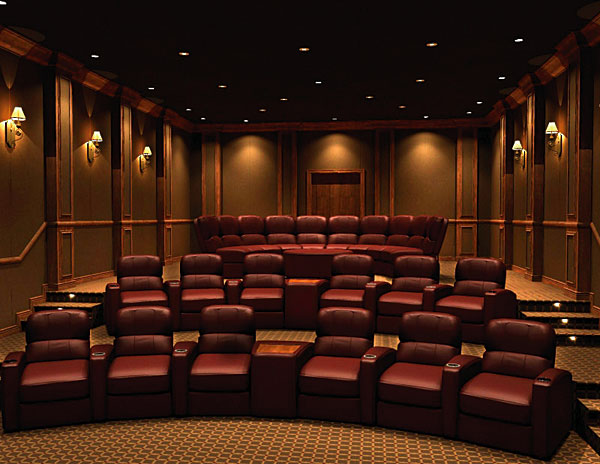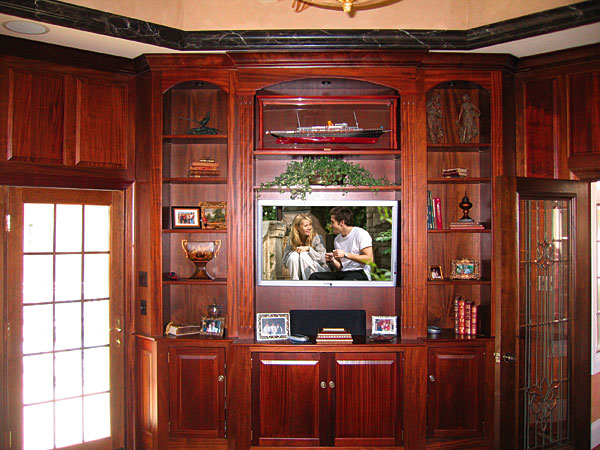Making Media Rooms Work
 What's possible these days—and how much or how little money does it take?
What's possible these days—and how much or how little money does it take?
There's a dessert at a 100-plus-year-old Queens ice-cream parlor in New York City called "The Kitchen Sink." It consists of a huge, stainless-steel bowl crammed with 22 flavors of ice cream. The concoction was enhanced with a choice of any of 11 syrups or other toppings, whipped cream, and cherries. It certainly wasn't at the low end of the pricing scale. But, on the other hand, it left nothing out, and that was part of the appeal.
And so it is in the world of home theater electronics, with media rooms as the proverbial kitchen sink. But media rooms cost a bit more than ice-cream sundaes, so satisfying those special clients who hanker for a taste, within a single space, of every electronic flavor available—from standard home entertainment audio and video fare, to Internet surfing, to gaming, to digital imaging manipulation and display capability—poses a unique challenge. Two custom-integration whizzes with proven expertise at serving up all manner of satisfying media—Joe Hart, systems designer at Broomall, Pennsylvania's HiFi House and Scott Fuelling, president of Phoenix Unequaled Home Entertainment in Memphis, Tennessee—explain just what combinations of products, pricing, and planning have worked best in their most successful recipes for media rooms.

Q: While most consumers could easily guess the elements that make up a home theater, they might not so easily imagine what would or could comprise a media room. Can you go into some particulars about how many—or how few—elements could make a room into a media room?
Joe Hart: It's a matter of semantics. I've met people who think that any place to watch movies with a surround sound system is a home theater, or it could also include a popcorn machine, velvet curtains, and movie posters. To me, a home theater is more of an experience that duplicates the effect of going to a movie theater. That could be a living room where everything's designed to be hidden, or a dedicated viewing space. A media room, to a lot of folks, is more a multipurpose family space that includes TV, an audio surround system, games for the kids, and Internet access—which is showing up just about everywhere. It's in lots of the theaters we do, for gaming with players in other places. You could also factor in digital photo manipulations, but we don't have too many requests yet for that.
"Media" is such a vague term—I think of the nerdy character Rick Moranis used to do on Second City TV as the guy with six TV screens on the wall—it was like the pocket-protector version of home theater. It sounds techy and computer-centric. Does anyone really go into the living room to sit in a big chair and try to use their computer for anything other than surfing and e-mail?
Scott Fuelling: Our company uses the term "media room" to describe a multipurpose area of the home. While a home theater is often a dedicated space in the home used exclusively for movie viewing, the media room may be forced into more diverse duty. The ability for the media system to deftly handle multiple sources and perform at high levels is important to our clients, but the system must be able to fade into the background when not in use.

Q: Given all the various elements in a media room and the multipurpose nature of such a room, is it possible to hide most of the gear, as you can almost always do in a home theater? Do most media-room customers really want the equipment hidden, or are they the types of clients who like to have a NASA-like look to their media room, with plenty of exposed talking points for when they have friends over?
JH: Most don't want to see a lot of stuff hanging out. They want it cleaned up, hidden, and out of sight. The screen may be exposed, but they don't want to see a computer desk or the kids' gaming stuff. We have a lot of requests for down-low cabinets, typically, where the plate with all the connections and game accessories can be pulled out and then raked back into the cabinet later. With the doors closed and everything looking like this, the room is a place where people would come and visit. Some want, even in a dedicated viewing space, an equipment rack behind doors that is also accessible so that they can open it up. When people ask, "How much did it cost?" the owners can show them and say, "Well, this is my processor, my DVD player, and this, and that," and give them the numbers. It's the kind of deal where the guy gets the new car and opens the hood for his buddies, and they have no clue what they're looking at underneath it—except maybe they could point to a spark plug. It's typically not right out in the open. It's in their pockets, as opposed to being worn as a bow tie.
SF: Our firm's location in the Deep South translates to us working in many traditionally decorated homes. Electronics rarely have a place in old-South interior décors. The vast majority of our projects involve hiding the components, and this design criterion forces us to stay creative and provide designs that meet our performance expectations without dominating a formal interior.
Q: Can you give some classic examples of media rooms you've worked on?
SF: A textbook example of a media-room system from our firm would involve a large video display (usually plasma or LCD) working in conjunction with a multichannel surround sound system. Basic sources include the norm: DVD, cable, DSS, HDTV (including off-air), and various audio sources (CD, XM, Sirius, iPod, and so on). Quite often, we add a PC interface and gaming ports for an Xbox and a PS2. A control system from AMX or Control4 can bring the entire system together in a cohesive, easy-to-use package for our client's entire family.
JH: I did one room for a guy a few years ago with a political position. It was a setup with a surround system, a big screen on one side of the room, and three duplicate TVs so that he could keep an eye on the networks' coverage at the same time. Another was a client with a home office/media room set up so that he could watch a 42-inch LCD TV, a 30-inch LCD, three 23-inch monitors on a desktop, four computers, two satellite receivers, and two cable boxes. It cost him about $40,000. He can bang away at an e-mail while MSNBC is on, and, if he hears something in a report about the subject he works on, which is health care, he can just pull it off and patch it into a presentation to investors he's readying for a meeting a few days later. He has a switching matrix to direct the cable boxes and the satellite receivers or the four computers to any of the monitors. That's the heavy tech-type media room.
At the other extreme, one I did a while back was a living room with a 50-inch plasma TV on the wall and a surround system tucked into a closet around the corner. On the wall, below the TV, is a plate that has a connector where you can plug in a cable from a laptop, or the kids can plug in their games. That cost about $13,000; but, now, with the drop in screen prices, it would run around $10,000.
 Joe Hart
Joe Hart
Joe Hart, systems designer at Broomall, Pennsylvania's HiFi House (www.hifihousegroup.com), handles systems design, client meetings, project evaluation, job coordination, and supervision. His first exposure to hi-fi was when he was an undergraduate at Penn State, where he entered the electronics retailing trade, a career he pursued later in Connecticut before returning to Pennsylvania.
 Scott Fuelling
Scott Fuelling
Scott Fuelling, president of Memphis, Tennessee's Phoenix Unequaled Home Entertainment (www.phoenixcommcorp.com), has been working in the custom business for about 23 years. In college, he was employed by a commercial/industrial electrical contractor as a project manager over modular electrical wiring systems and also worked as an independent low-voltage systems contractor on many commercial installations. After being involved with several low-voltage contracting firms (both commercial and residential) in the Memphis area, he formed Phoenix in June 1994, with a target market of high-end residential integration projects.
"We have always loved the challenges faced by residential integrations," Fuelling says, "and we work hand in hand with many of the trades on each project, such as electrical, HVAC, and pool contractors. We also have the challenge of blending the technologies into the homes' décor. Satisfying the homeowners' desires for the technology while pleasing the interior designers is a daily process. I have been fortunate, as we have assembled one of the best teams in the industry. I put our knowledge base and talent against any other firm, locally or even nationally. "





























































